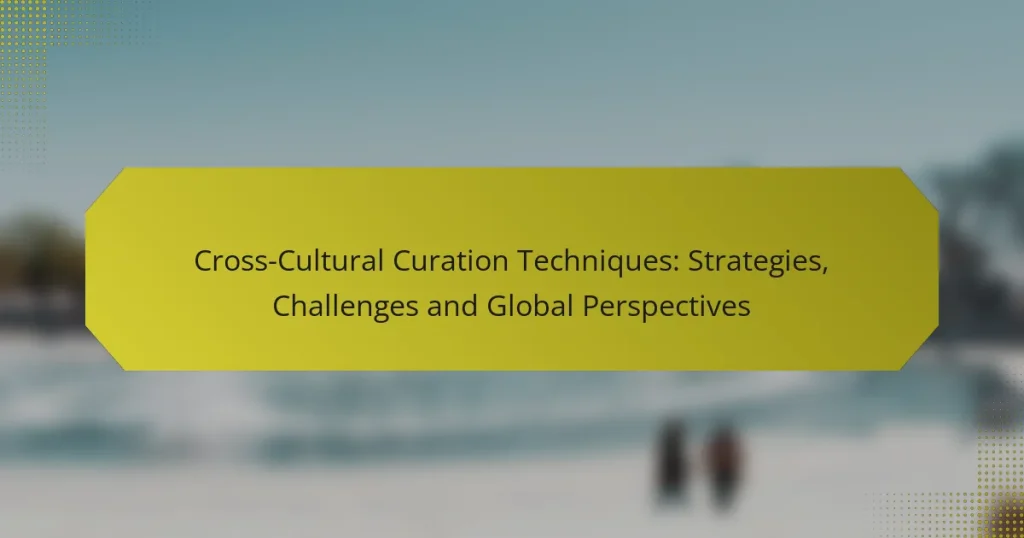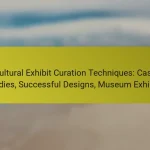Cross-cultural curation techniques are essential for integrating diverse cultural perspectives into content presentation, fostering inclusivity and engagement among varied audiences. By emphasizing cultural sensitivity, these methods enhance understanding and build trust, while also addressing challenges such as language barriers and misinterpretation of cultural symbols. Effective curation not only enriches the content but also promotes meaningful connections across different backgrounds.
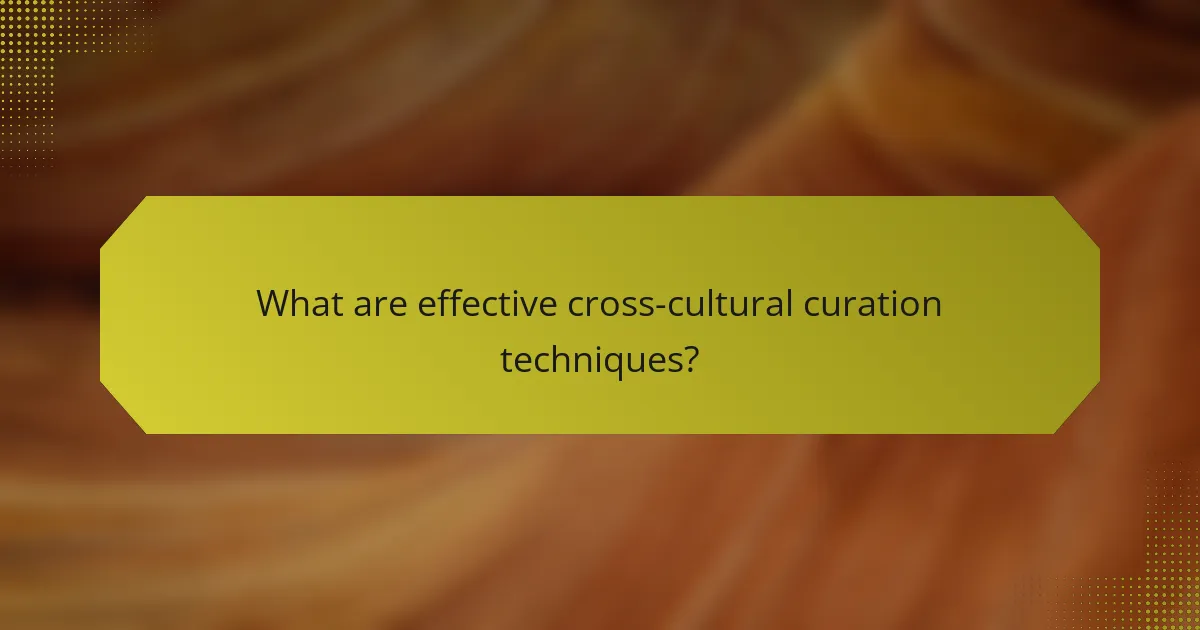
What are effective cross-cultural curation techniques?
Effective cross-cultural curation techniques involve methods that respect and integrate diverse cultural perspectives while presenting content. These techniques enhance understanding and appreciation among varied audiences, fostering inclusivity and engagement.
Storytelling in curation
Storytelling is a powerful tool in cross-cultural curation, as it helps convey complex cultural narratives in relatable ways. By weaving personal stories or historical contexts into curated content, curators can create emotional connections that resonate with diverse audiences.
Consider using local legends or contemporary experiences that reflect the culture being represented. This approach not only educates but also invites audiences to engage with the material on a deeper level, fostering empathy and understanding.
Collaborative projects with local artists
Collaborating with local artists is essential for authentic cross-cultural curation. These partnerships ensure that the curated content accurately reflects the cultural nuances and values of the community. Engaging local talent can also enhance the credibility and appeal of the project.
When planning collaborations, establish clear communication and mutual respect. This can involve workshops, joint exhibitions, or community events that highlight the contributions of local artists, thus enriching the overall curation process.
Utilizing digital platforms for global reach
Digital platforms are invaluable for extending the reach of cross-cultural curation efforts. They allow curators to share diverse content with a global audience, breaking geographical barriers and fostering international dialogue.
Utilize social media, virtual exhibitions, and online workshops to engage with audiences worldwide. Consider platforms that support multimedia content, enabling richer storytelling through videos, podcasts, and interactive elements. This approach not only broadens access but also invites feedback and participation from a wider demographic.
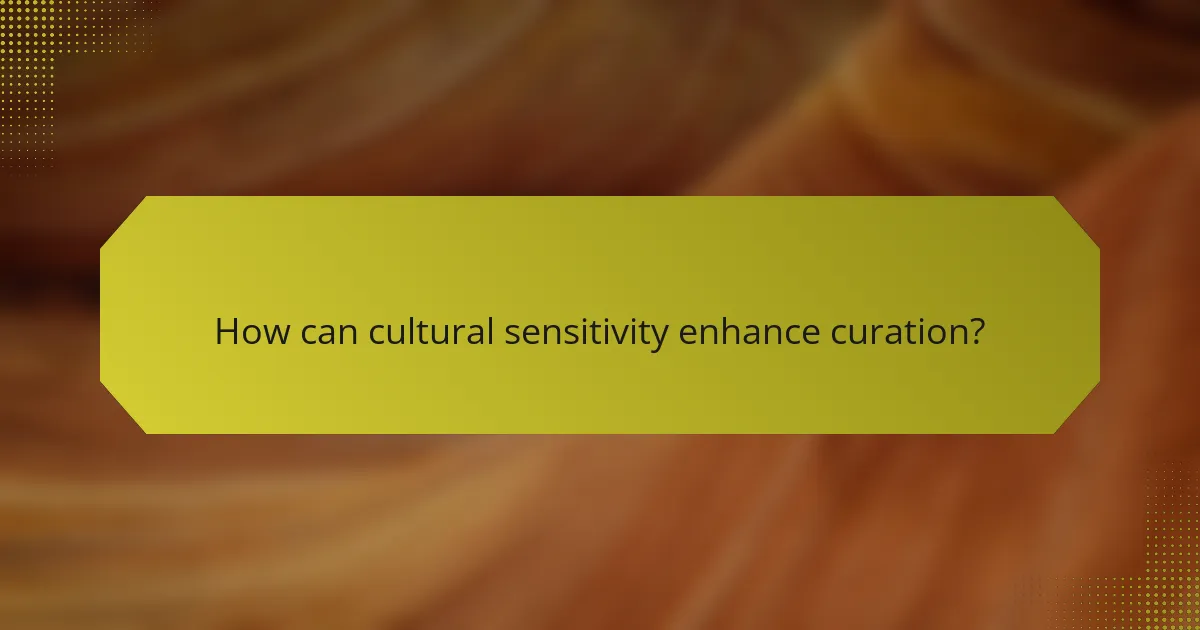
How can cultural sensitivity enhance curation?
Cultural sensitivity enhances curation by fostering respect and understanding of diverse cultures, leading to more meaningful and relevant presentations. This approach not only enriches the curated content but also builds trust and engagement with audiences from various backgrounds.
Understanding local customs and traditions
To effectively curate content, it’s essential to grasp the local customs and traditions of the culture in focus. This understanding helps avoid misrepresentation and ensures that the curated material resonates with the community’s values and beliefs.
For example, when showcasing art from a specific region, recognizing the significance of certain symbols or colors can enhance the audience’s appreciation. Curators should research local practices and consult cultural experts to gain insights into what is considered respectful and appropriate.
Engaging with community stakeholders
Engaging with community stakeholders is crucial for successful curation. This involves collaborating with local artists, historians, and cultural leaders to ensure that the curated content accurately reflects the community’s identity and narratives.
Curators should prioritize building relationships with these stakeholders, as their input can provide valuable perspectives and help identify potential pitfalls. Regular meetings and open communication channels can facilitate a collaborative environment, ensuring that the curation process is inclusive and representative.

What challenges arise in cross-cultural curation?
Cross-cultural curation faces several challenges that can hinder effective communication and representation. These challenges include language barriers, misinterpretation of cultural symbols, and resource allocation issues, each requiring careful consideration to ensure respectful and accurate curation.
Language barriers
Language barriers can significantly impede cross-cultural curation by creating misunderstandings and miscommunications. When curators and audiences speak different languages, nuances and meanings may be lost, leading to incorrect interpretations of content.
To mitigate these issues, it’s crucial to employ professional translators and cultural consultants who understand both the source and target languages. Utilizing visual aids and multilingual labels can also enhance understanding and accessibility for diverse audiences.
Misinterpretation of cultural symbols
Misinterpretation of cultural symbols can occur when curators lack a deep understanding of the cultural context behind certain artifacts or practices. Symbols that hold significant meaning in one culture may be misunderstood or misrepresented in another, leading to potential offense or confusion.
To avoid this pitfall, curators should conduct thorough research and engage with cultural representatives during the curation process. Providing context through explanatory materials can help audiences grasp the intended meanings of cultural symbols.
Resource allocation issues
Resource allocation issues can arise when curators attempt to balance the needs of various cultures while managing limited budgets and time constraints. This can lead to inadequate representation or support for certain cultural perspectives, ultimately affecting the quality of the curation.
Effective planning and prioritization are essential to address these challenges. Curators should assess the importance of each cultural element and allocate resources accordingly, ensuring that all voices are heard and represented fairly. Collaborating with local organizations can also provide additional support and resources.
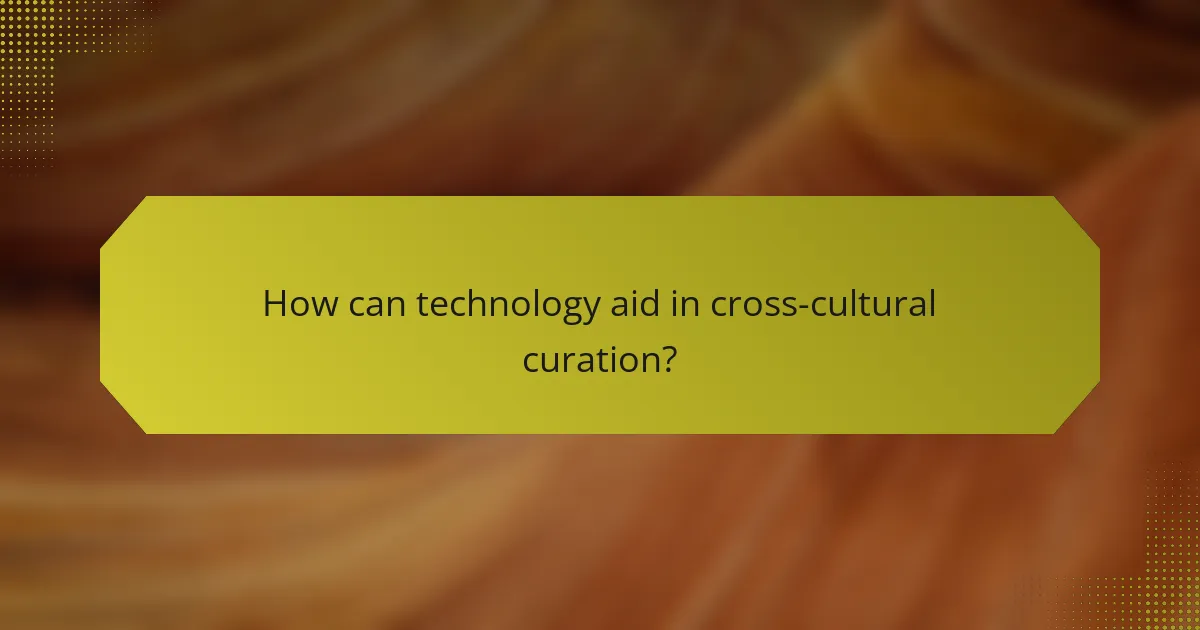
How can technology aid in cross-cultural curation?
Technology enhances cross-cultural curation by providing tools that facilitate collaboration, immersion, and accessibility. These advancements allow curators to engage diverse audiences and present cultural artifacts in innovative ways.
Virtual reality experiences
Virtual reality (VR) experiences can transport users to different cultural settings, allowing them to engage with artifacts and environments in an immersive manner. This technology can simulate historical events or cultural practices, providing a deeper understanding of diverse traditions.
When implementing VR, consider the target audience’s access to technology and the potential costs involved. High-quality VR experiences can be resource-intensive, so it’s essential to balance quality with accessibility.
For example, a museum could create a VR tour of an ancient city, enabling users to explore its architecture and daily life. This approach can attract a wider audience, including those unable to visit in person.
Online collaborative tools
Online collaborative tools facilitate communication and project management among curators from different cultural backgrounds. Platforms like Google Workspace or Trello allow teams to share ideas, resources, and feedback in real-time, breaking down geographical barriers.
Utilizing these tools effectively requires establishing clear guidelines for collaboration and ensuring all team members are comfortable with the technology. Regular check-ins can help maintain alignment and address any challenges that arise.
For instance, a cross-cultural project might involve curators from various countries working together to create a digital exhibition. Using collaborative tools can streamline the process, ensuring diverse perspectives are integrated into the final product.

What frameworks support effective cross-cultural curation?
Effective cross-cultural curation relies on frameworks that facilitate understanding and collaboration among diverse cultural perspectives. These frameworks help curators navigate the complexities of cultural differences, ensuring that exhibitions resonate with a global audience.
Intercultural communication models
Intercultural communication models provide essential insights into how people from different cultures interact and understand each other. Models such as Hofstede’s Cultural Dimensions and Hall’s High-Context and Low-Context Communication help curators identify key cultural values and communication styles. Understanding these models can guide curators in tailoring their messaging and presentation to align with the cultural expectations of their audience.
For instance, in a high-context culture, non-verbal cues and implicit messages may carry more weight than explicit verbal communication. Curators should consider these nuances when designing exhibitions to ensure that the intended message is conveyed effectively.
Best practices in global art exhibitions
Best practices in global art exhibitions emphasize inclusivity and representation of diverse voices. Curators should engage with local artists and communities to ensure that the exhibition reflects authentic cultural narratives. This collaboration not only enriches the exhibition but also fosters community support and engagement.
Additionally, curators should be mindful of cultural sensitivities and avoid appropriation. Establishing guidelines for ethical representation and involving cultural consultants can help mitigate potential misunderstandings. A checklist for curators might include: consulting with local stakeholders, conducting cultural research, and ensuring diverse representation in the selection of artworks.
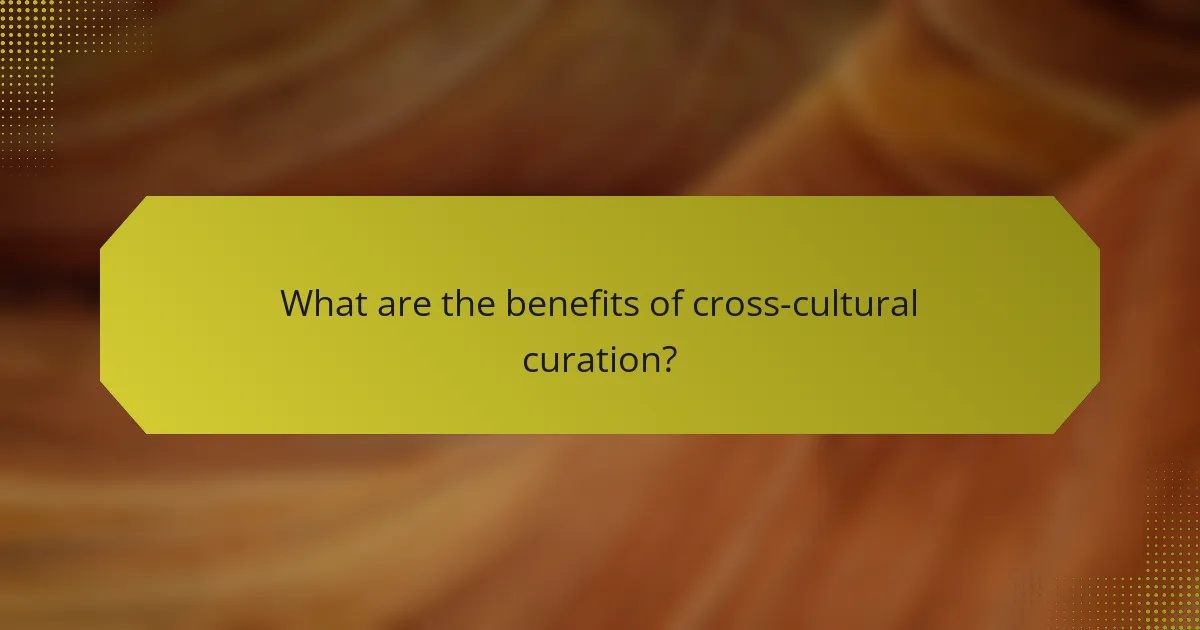
What are the benefits of cross-cultural curation?
Cross-cultural curation offers numerous advantages, including the promotion of diversity and the enrichment of content through varied perspectives. It enhances the understanding of different cultures while fostering connections among diverse audiences.
Fostering global understanding
Cross-cultural curation plays a crucial role in fostering global understanding by bridging cultural gaps. By showcasing diverse narratives, it encourages empathy and appreciation for different traditions and values.
To effectively foster understanding, curators should select content that highlights shared human experiences while respecting cultural differences. This can include art, literature, and multimedia that resonate across borders, promoting dialogue and collaboration.
Enhancing audience engagement
Engaging audiences through cross-cultural curation can significantly increase interest and participation. By presenting diverse viewpoints, curators can attract a broader audience and stimulate discussions that enrich the experience.
To enhance engagement, consider incorporating interactive elements such as workshops or discussions that allow audiences to share their perspectives. Utilizing social media platforms to promote curated content can also amplify reach and encourage community involvement.
